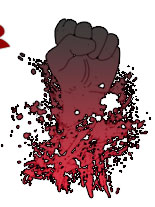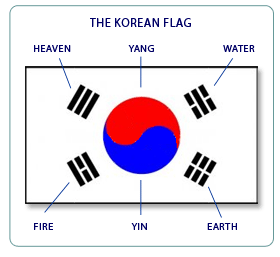 |
 |
| Korean and other TKD Terminology |
"Tae" means "foot"
or "to strike with the feet". "Kwon" means "hand", or "to strike with the
hand". "Do" means discipline, art, or way.
Hence TaeKwonDo (foot-hand-way) means literally "the art of the feet and the hands" or "the art
of kicking and punching".

The Korean Flag:
The
Korean flag symbolizes much of the thought and philosophy
of the Orient. The symbol, and sometimes the flag itself,
is called T'ae Kuk.
Depicted on the flag is a circle divided
equally and locked in perfect balance. The red section represents
the Yang (plus) and the blue section the Um (minus), an ancient
symbol of the universe which originated in China. These two
opposites express the dualism of the cosmos: fire and water,
day and night, dark and light, construction and destruction,
masculine and feminine, active and passive, heat and cold,
plus and minus, and so on.
The central thought in the T'ae Kuk
indicates that while there is a constant movement within
the sphere of infinity, there are also balance and harmony.
Three bars at each corner also carry
the ideas of opposition and balance. The three unbroken bars
stand for heaven; the opposite three broken bars represent
the earth; the two bars with a broken bar in-between symbolize
fire; the opposite is the symbol of water.
Things that you will hear in class. Listen Carefully! and Learn.
| Basics |
|
- Tae Kwon Do - Foot-Hand-Art/Mind
- School / Gym - Do Jang
- Master - Sabomnim "Sah-bum-nim" (Sir)
- Instructor (Black Belt) - Kyo sah nim
- Uniform - Do bok
- Belt - Ti (pronounced Dee)
- Flag - Kook Ki
- Bow - Kyungnet (Coon yay)
- Grade (Color Belt) - Gup
- Poomse / Tul - Pattern
- Attention - Charyut "Chari-yut"
- Thank you - Kamsa Hamnae Da
"Kam-sa-ham-nida" (at the end of our class bowing to Sir)
- Yell - Kihap "Kee-yah-p" (word to use when you are kicking or punching for power)
- Return (as in turn & face the Master at the end of your form) - "Ba-ro"
- Stop - Gunman
- 4-Direction - Saji
|
- Hand Techniques
- Thrust - Jirugi (Chirugi)
- Strike - TulgiTaerigi
- Block - Makgi
- Vital Spots - Kupso
- BLOCKS
- Rising - Chookyo
- Guarding - Daebi
- Twin Forearm - Sang Palmok
- Double Forearm - Doo Palmok
- Wedging - Hechyo
- Circular - Dollimyo
- Hooking - Golcho
- Upward - Ollyo
- Downward - Naeryo
- Kick - Chagi "Cha-gi"
- Ready Stance - Joon bi (Choon bi)
|
KICKS - Chagi
- Chagi - Kick
- Ap Chagi - Front Kick
- Yop Chagi -
Side Kick
- Dolliyo Chagi - Turning Kick
- Dwi Chagi - Back
Kick
- Horyo Chagi - Reverse Turning Kick
- Ap Horyo Chagi -
Hook Kick
- Naeryo Chagi - Axe Kick
- An Chagi - Inner Crescent
Kick
- Bakat Chagi - Outer Crescent Kick
- Mirro Chagi - Push
Kick
- Ap Dolliyo Chagi - Front Turning Kick
- Bituereo Chagi -
Twisting Kick
- Cha Jun Bal Chagi - Skipping Kick
- Twimeo Chagi - Jumping Kick
- Chagi Undong - Kicking Excercise
|
|
| Other |
|
|
|
|
Walking |
Gunnin |
|
Front |
Up (Ap) |
|
L |
Niun |
|
Back |
Dwi |
|
Sitting |
Annun |
|
Side |
Yop |
|
Fixed |
Gojung |
|
High |
Eulgool |
|
Low |
Naucho |
|
Middle |
Momtong |
|
X |
Kyocha |
|
Low |
Arae |
|
Closed |
Moa |
|
Left |
Wen |
|
Rear
Foot |
Dwitbal |
|
Right |
Oreun |
|
Ready |
Junbii |
|
Outward |
Bakkat |
|
Bending
Ready |
Gubryo
Junbi |
|
Inward |
An |
|
Parallel
Ready |
Narani
Junbi |
|
Downward |
Naeryo |
|
Vertical |
Soo
Jik |
|
Upward |
Ollyo |
|
High |
Nopunde |
|
Sideways (Turning) |
Dollyo |
|
Middle |
Kaunde |
|
|
|
|
Side |
Yop |
|
|
|
|
Inward |
Anuro |
|
|
|
|
Outward |
Bakuro |
|
|
|
|
Right |
Orun |
|
|
|
|
Left |
Wen |
|
|
|
|
Inner |
An |
|
|
|
|
Outer |
Bakat |
|
|
|
|
Sliding |
Mikulgi |
|
|
|
|
Push-Ups |
Momtong
Bachim |
|
|
|
|
Turn
Around |
Dwirodora |
|
|
|
|
Forward |
Apro |
|
|
|
|
Backward |
Muluswimyu |
|
|
|
|
Self
Defense |
Hosin
Sul |
|
|
|
Belt Colour Meanings
- WHITE: Signifies innocence as that of a beginning student who has no previous knowledge of TaeKwon-Do.
- YELLOW: Signifies the earth or the seed from which a plant sprouts and takes root as the TaeKwon-Do foundation is being laid.
- GREEN: Signifies the plant's growth as the TaeKwon-Do skills begin to develop.
- BLUE: Signifies the heavens towards which the plant matures into a towering tree as training in TaeKwon-Do progresses.
- RED: Signifies danger, cautioning the student to exercise control and warning the opponent to stay away.
- BLACK: Is the opposite of white, therefore, signifies the maturity and proficiency in TaeKwon-Do. It also indicates the wearer's imperviousness to darkness and fear.
GTF TAEKWON-DO PATTERNS
After the establishment of GTF in 1990, Grand Master Park Jung Tae added 6 patterns to the original 24 ITF patterns. These are Jee-Sang, Dhan-Goon, Jee-Goo, Jook-Am, Pyong-Hwa and Sun-Duk.
Pattern practice enables the student to develop sparring techniques, improve flexibility of movements, master body shifting, build muscles and breath control, develop fluid and smooth motions, and gain rhythmical movements. It also enables a student to acquire certain special techniques which cannot be obtained from either fundamental exercises or sparring.
REMEMBER:
- Patterns should begin and end at exactly the same spot.
- Correct posture and facing must be maintained at all times.
- Muscles of the body should be either tensed or relaxed at the proper critical moments in the exercise.
- The exercise should be performed in a rhythmic movement with an absence of stiffness.
- Movement should be accelerated or decelerated accordingly.
- Each pattern should be perfected before moving to the next.
- Students should know the purpose of each movement.
- Students should perform each movement with realism.
- Attack and defence techniques should be equally distributed among right and left hands and feet.
|





